 Marcus Graf Yazio: Fevzi Karakoç – İmgenin Ötesi
Marcus Graf Yazio: Fevzi Karakoç – İmgenin Ötesi
“İmgenin Ötesi”, Fevzi Karakoç'un son birkaç yılda ürettiği resimlerini sunarak sanatçının çalışmalarının mevcut durumunu ortaya koyuyor. Sergi, sanatçının mantıkla duyguyu nasıl bir araya getirdiğinin yanı sıra, seri tekrarı jestsel anlatımla birleştirerek alternatif resim biçimlerini ve kavramlarını nasıl ortaya çıkardığını gözler önüne seriyor. Eserlerinin, özellikle bu eşsiz karakteristiği, külliyatını çağdaş resim sanatının önemli bir örneği haline getirmektedir. Karakoç, geleneksel figüratif ve soyut sanat kavramlarının ötesine geçmek için rasyonalizm ve ampirizm arasındaki bağlantı yoluyla modern sanatın eski katı sınırlarını görmezden gelir.
1968-1990 yılları arasındaki, sanatçının kişilerarası ve toplumsal ilişkilere olan ilgisiyle karakterize edilen bir dönemden sonra, figürlerin seri tekrarı ve “sanat, sanat içindir” görüşünün ardından soyutlamaya duyduğu ilgi, Karakoç'un baskın sanatsal stratejisi haline gelir.
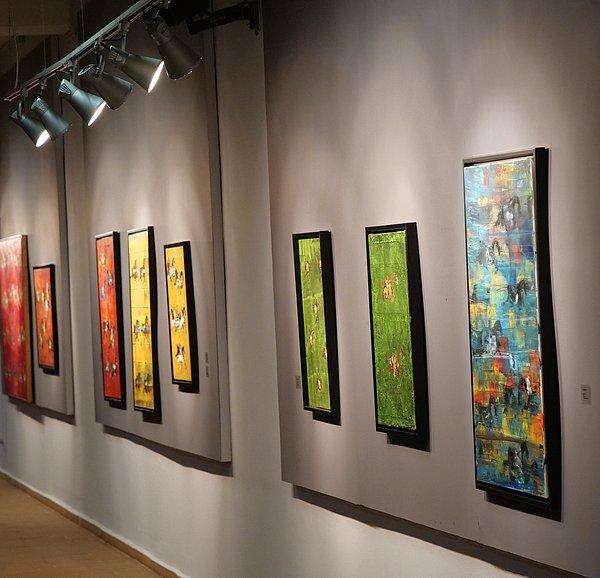
O zamandan beri sanatçı, rengin, figürün ve resmin özünün anlamını ortaya çıkarmaya odaklanıyor.
Ressimsel biçimcilik ekolünü takip ederek, sanatçı, sanatı doğrusal mesajları iletmek için bir araç olarak anlamlandırmaz. Karakoç, resmi daha çok belirli biçimsel parametrelere sahip bağımsız bir varoluş olarak görür ve içsel kavramsal meselelerle ilgilenir. Bu yüzden resimler asla illüstrasyon değildir. Gerçekten de, genellikle atları tasvir ederler. Bununla birlikte, atlar hiçbir zaman somut semboller değildir, çünkü sanatçı onları renk, şekil ve doku gibi resmin kompozisyonunun estetik unsurları olarak kullanır. Fevzi Karakoç çalışmalarını, resim sanatını daha ileri noktalara taşımak için, onun biçimsel ve kavramsal varlığının sanatsal araştırmasına adamıştır.
Sanatçı, güncel çalışmalarında soyutlama derecesini artırarak bir resim yaratma sürecini daha da güçlü bir şekilde ortaya koymaktadır. Bu nedenle, bazen monokrom, bazen de sanatçının koşan atların tekrarlayan görüntülerini yerleştirdiği etkileyici bir şekilde boyanmış bir arka plandan parlayan renk, Karakoç’un son çalışmalarında daha baskın hale gelmiştir.
Şamanizm ve tasavvufta olduğu kadar savaş ve sporda da bulunabilen at, güçlü bir semboldür. Fevzi Karkoç'un resimlerinde atlar, çocukluğuna önemli göndermeler yapsa da, kompozisyonun daha çok biçimsel öğeleridir. Öncelikle izleyicinin dikkatini çekmesi nedeniyle gözlem ve algılama sürecinin bir başlangıç noktasıdır. Atlara odaklanırken göz, rengin gücünü ve güzelliğini keşfetmek için eserin sayısız katman ve dokuları arasında kaybolur. Eserde figürler alışıldık zaman ve mekânlarından koptuğu için eski anlamlarını kaybederler. Bu nedenle at figürleri, tablonun kendisinden başka hiçbir şeyle ilgili olmadıkları için birer sembol işlevi görmezler.
Resimlerinin figüratif boyutu şu anda daha güçlü bir şekilde küçültülmüştür.
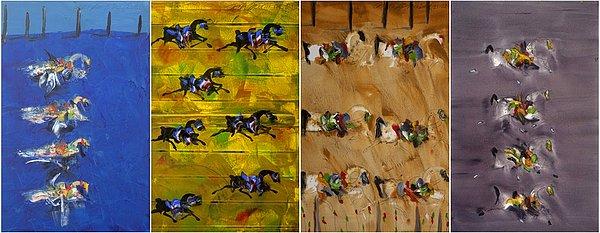
Mavi Sürgün / Sarıya Atlayış / Çöl Sıcağı / Rengini Seven Atlar
Atların binicilerini kaybetmesiyle, insan merkezli ve anlatısal karakter minimal bir hal almıştır. Ayrıca, herhangi bir natüralist çağrışım yapmamak adına daha çok eskiz gibi tasvir edilmişlerdir. Nihayetinde, bazı resimlerde, Karakoç’un üzerlerine etkileyici kalın boya kümeleri ve ağır fırça darbeleri eklediği atlar yok olmaya yüz tutmuştur. Diğer eserlerinde ise Karakoç, spatula kullanır ve figürlerin üzerini çizerek deforme olmuş ve çarpık görüntüler oluşturur. Figürler, arka planın üzerinde konumlandıkları önceki serilerin aksine, şimdi eskisinden daha güçlü bir psiko-görsel etkiye sahip olan arka planla bütünleşmiş görünürler. Arka plan, bazen minimal ve sakin görünümlü monokrom bir alan olarak tasvir edilirken, diğer resimlerde, çok sayıda şekil ve dokuyu ortaya çıkaran etkileyici fırça darbeleriyle inşa edilmiştir. Bu eserler, tüm kompozisyonun dinamizmini baştan sona destekleyen güçlü bir momentuma sahiptir ve bu nedenle resim sanatının estetik gücüne atıfta bulunur.
İzleyici, eserleri incelerken, resimlerinin yapıları ile heterojen gerçekliğimiz arasındaki benzerliği fark edebilir. Tuvaldeki figürler, kolaylıkla anladığımız görüntülere benzerler. Bununla birlikte, kompozisyon içindeki resimsel işlevinden başka bir şeye atıfta bulunmazlar. Bunları takip etmek izleyiciyi, sanatın özü ve yaşamın temellerinin yanı sıra, sanat eserinin parçalı yapısı ile alakadar olduğumuz karmaşık gerçeklik yapıları arasındaki benzerliğin ortaya çıktığı heyecan verici bir yolculuğa çıkaracaktır. Sonuç olarak, resmin sayısız katmanı arasında hem sanatta hem de gerçeklikte şaşırtıcı ve ilham verici anlayışlar ortaya çıkıyor. Bu nedenle Karakoç'un eseri sonuçta sanatın özüne yönelik arayışın hayatımızla paralellik gösterdiğini kanıtlıyor.
Fevzi Karakoç – İmgenin Ötesi
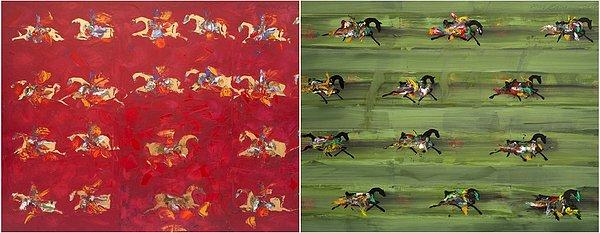
Tepeden Haliç / Nar ve Armutlar
“İmgenin Ötesi” presents Fevzi Karakoç’s paintings of the last few years, and so reveals the current state of his work. The exhibition exposes how the artist merges logic with emotion as well as how he finds alternative forms and concepts of painting by combining serial repetition with gestural expression. Especially this unique characteristic makes his oeuvre an important example of contemporary painting. Karakoç ignores the former strict boarders of modern art through the interconnection of rationalism and empiricism for going beyond the traditional notions of figurative and abstract art.
After a period between 1968 and 1990, which is characterized by Karakoç’s interest in interpersonal and social relationships, the serial repetition of figures and an interest in abstraction following the notion of “art for its own sake” become his dominant artistic strategy.
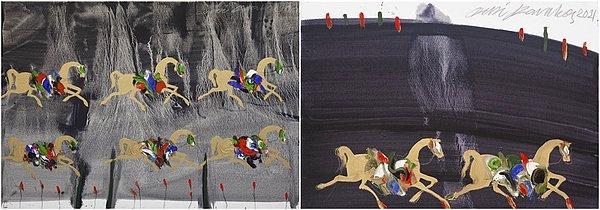
Akşam Olurken / Gökyüzü Delindi
Since then, the artist strongly concentrates on revealing the meaning of colour, figure, and the essence of painting.
Following the school of painterly formalism, he does not understand art as an instrument for communicating linear messages. Karakoç rather sees painting as an independent existence that has specific formal parameters and deals with intrinsic conceptual matters. That is why the paintings are never illustrations. Indeed, they often depict horses. Nevertheless, the horses are never concrete symbols, as the artist uses them as aesthetic elements of the painting’s composition just like colour, shape, and texture. Indeed, Fevzi Karakoç dedicates his work to the artistic research of the formal and conceptual being of the art of painting to propel his work to further grounds.
In his current works, the artist reveals the process of creating a painting even stronger by increasing the grade of abstraction. That is why color became more dominant in the latest pieces. It shines from a sometimes monochrome, at other times expressively painted background onto which the artist still sets repetitive images of running horses.
The horse is a powerful symbol. It can be found in shamanism and mysticism as well as in warfare and sports. Though, in Fevzi Karkoç’s paintings, while having a significant reference to his childhood, the horses are rather formal elements of the composition. They mean a starting point of the observation and perception process, as they firstly catch the attention of the spectator. While concentrating on the horses, the eye gets lost between the numerous layers and textures of the work for discovering the power and beauty of color. Within the work, the figures lose their former meaning, as they are disrupted from their usual time and space. This is the reason why the horse figures do not function as signs, as they relate to nothing else but to the painting itself.
The figurative dimension of his paintings is currently stronger reduced.
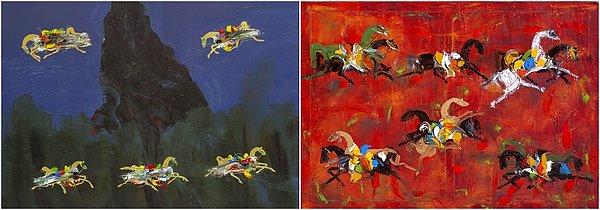
Dağda Ayin / Yürüyüş
The horses have lost their riders, so that the anthropocentric and narrative character appear as minimal. Also, the horses are more sketch-like depicted to prevent any naturalist connotations. In the end, in some paintings, the horses are even about to vanish, as Karakoç adds expressive clusters of thick paint and heavy brushstrokes over them. In other pieces, the artist uses a spatula, with which he scratches over the figures and so creates deformed and distorted images. In contrast to previous series, where the figures were standing above the background, now, they seem to become one with the background, which possesses a stronger psycho-visual impact than before. Sometimes, it is depicted as a minimal and calm-looking monochrome field. In other paintings, the ground is constructed with expressive brushstrokes that expose numerous shapes and textures. These works possess a powerful momentum that supports the all-over dynamism of the whole composition, and so refer to the aesthetic strength of the art of painting.
While observing his pieces, the spectator can recognize a similarity between the constructions of his paintings and our heterogeneous reality. The figures on the canvas resemble images, which we easily understand. Though, they refer to nothing but to their painterly function within the composition. Following them will take the spectator on an exciting journey to the essence of art, as well as to the basics of life, where the similarity between the piece's fragmented construction and the complex reality constructions we deal with are revealed. As a result, surprising and inspiring insights in art as well as in reality appear between the numerous layers of the painting. That is why in the end, Karakoç’s work proves that the quest to the essence of art shows parallels to our life.
Keşfet ile ziyaret ettiğin tüm kategorileri tek akışta gör!


Yorum Yazın